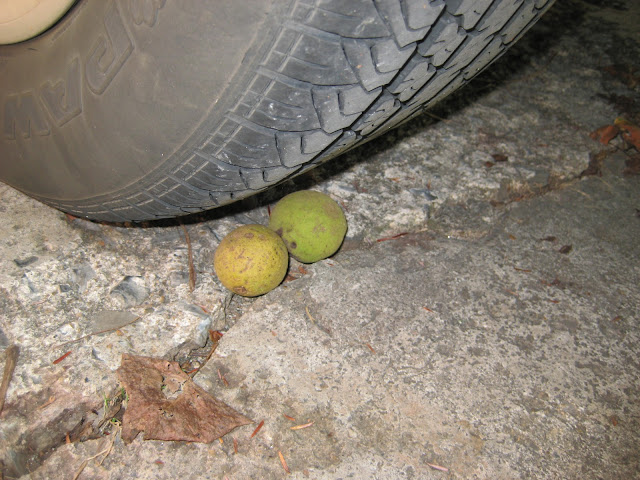This is the time of year that Black Walnut trees are dropping a tasty treat for foragers. This is my first year harvesting these difficult nuts. For years I have noticed how annoying those large, round, green balls are: they hit my car, litter yards, stain the road, just plain annoying. The past two years I started reading about foraging and this year I finally put in some field time when it came to Black Walnuts (I had heard they were difficult to harvest so I skipped doing it last year).
Black Walnut Tree:
If you are interested in foraging, please make sure to properly identify ANY wild plant that you are thinking about eating; be 100% sure it is what you think it is. I use a few field guides - Edible Wild Plants (Eastern/Central North America) by Lee Allen Peterson; Wildflowers of Tennesse the Ohio Valley and the Southern Appalachians by Horn, Cathcart, Hemmerly, Duhl; The Forager's Harvest (A Guide to Identifying, Harvesting and Preparing Edible Wild Plants) by Samuel Thayer. I also use the internet: http://www.eattheweeds.com, http://www.botanyeveryday.com
Underneath a Black Walnut tree you can find round, nuts that are contained in a green hull. I pick those that look like they have not been on the ground long/least amount of rotting on the hull.
To get the hulls off, I run over the Black Walnuts with my car. I place the nuts in a crack in the driveway. I used to just run them over on the driveway, but I noticed I was loosing a lot of choice/large nuts that way, the car was breaking the hull but also the nut shell. You want the nut shell in-tacked but the hull crushed so that you can remove it.
Crushed hull:
Don't handle the nuts/hulls directly & wear clothes you may not mind getting stained. Note the green/yellow juice that is seeping from them (above). It STAINS. (I had brown fingertips a few weeks back) Now I use rubber gloves to handle the nuts and to rip the hulls off.
I put the Black Walnuts in an old plant container with small holes in the bottom that I only use for Black Walnuts.
I use this as a strainer - wash the nuts well and then hang in a lemon, nut milk, or lingerie bag (don't expect to use it for your undies anymore because it stains it brown).
Hang dry the Black Walnuts inside (so squirrels won't steal them) for 2-4 weeks.
Now comes the fun part, smashing the shells! These nuts are tough to crack and the pieces fly everywhere, so please be careful. I wear safety glasses to protect my peepers.
See the nut meat hanging out of the shell ( bottom right of the photo)
I use the nut pick to help get out the nut meat that is stuck. Black Walnuts do not have the same flavor as English Walnuts, but they are still tasty and good for you. Some of the nuts I smashed today contained meat that was dried up, I just counted those as a loss.
Next, I went through my pile of nuts and picked out any shell that may have gotten in the edible pile (the meat & shell look similar).
I plan on adding these nuts to oatmeal in the morning.

















Why can't we be neighbors?! :)
ReplyDeleteAgain Jealous!!! If you happen to come into an abundance of of Walnuts you should send some my way so I can make a Tincture from them. Or better, maybe I should send you instructions on how to make Black Walnut Tincture (Hugely Anti-fungal) or Green Black Walnut Tincture (Strongly Anti-Parasitic). Then you would have little to no waste and another blog article! Love it!
ReplyDeleteGreat Stuff! Thanks for sharing.
ReplyDelete